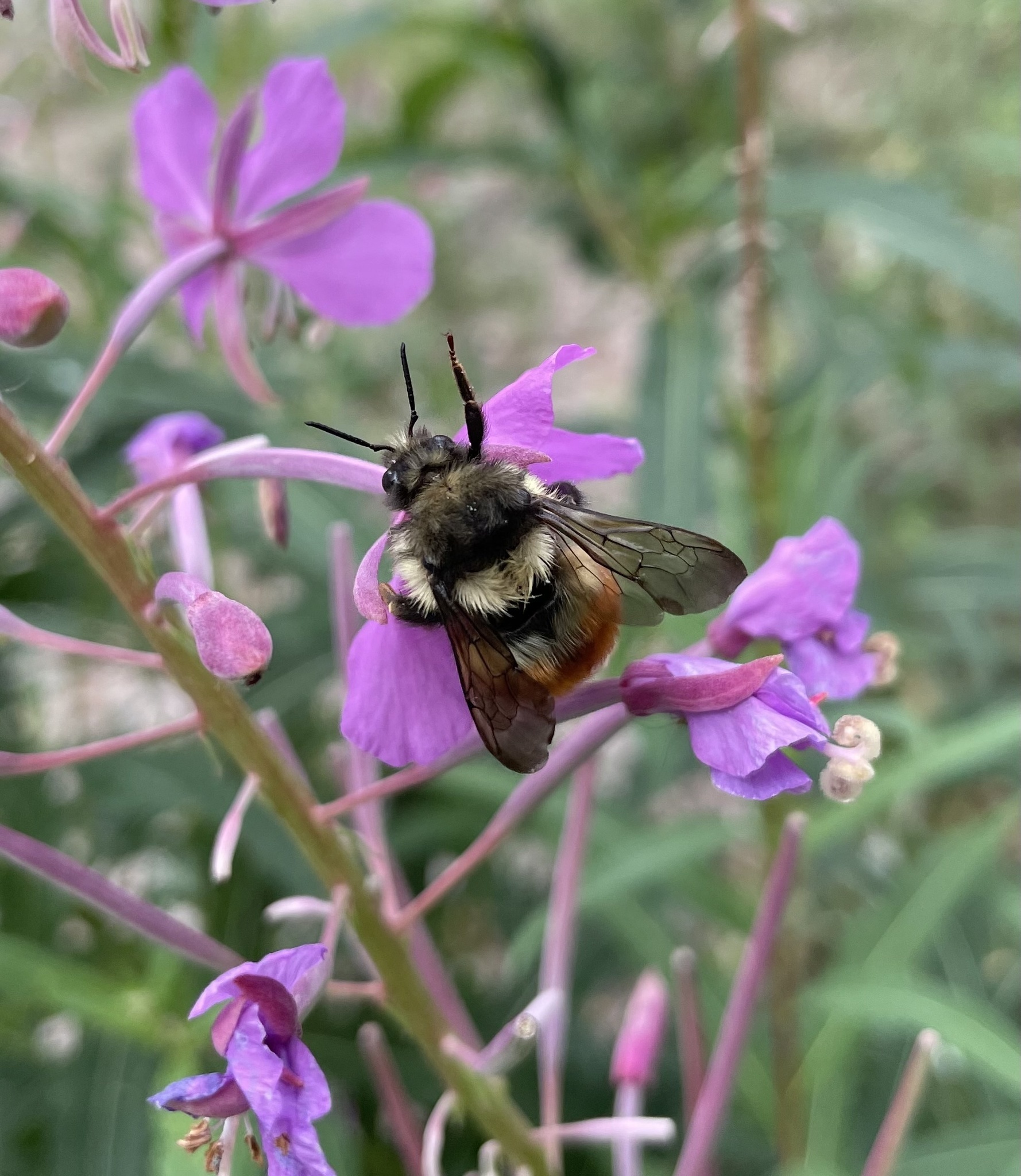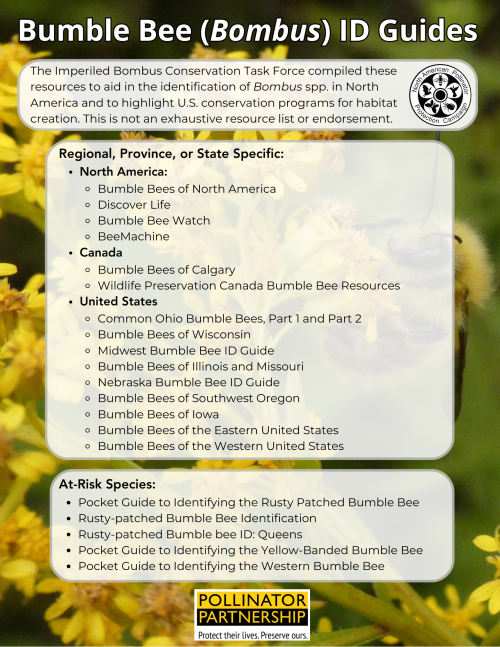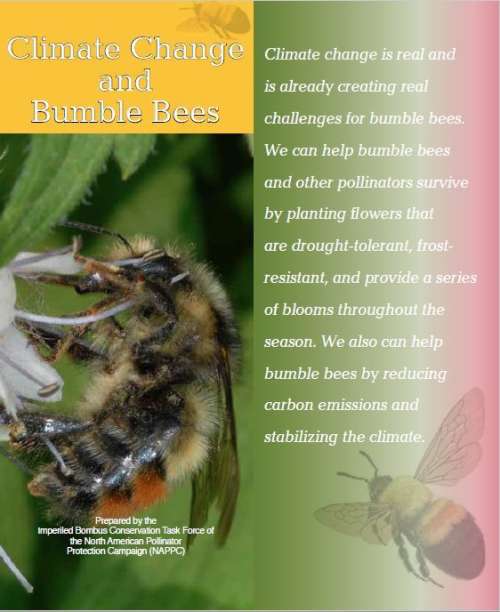Imperiled Bombus Conservation Task Force
The decline of bumble bees can have significant ecological and economic consequences. Although, it is difficult to pinpoint the causes of the declines and there are many unanswered questions about basic biology and ecology of these species, there are actions that can help conserve these species. This group will explore the role of NAPPC in making positive contributions to Bombus conservation and how best to augment and boost ongoing recovery actions.
Our Mission
We work to identify and address key stressors to imperiled bumble bee heath, determine critical bumble bee research needs, and promote scientifically sound conservation of bumble bees. This is accomplished through a bumble bee conservation grant program, development and dissemination of resources, and other focused projects (e.g., clean stock recommendations).
Call for Research Proposals Related to Imperiled Bombus Conservation
The 2026 grant application window is now OPEN.
Submit your proposal packets as a single PDF file to our application platform here by 5 PM EST on January 31. Email bombus@pollinator.org with any questions or concerns.
Download the English RFPDownload the Spanish RFP
Submission Form
Photo by Anthony Colangelo

Background
Over the past 25 years, the North American Pollinator Protection Campaign (NAPPC) has been an international force driving interest in the vital role and fragile status of native and managed pollinator species. NAPPC’s mission is to encourage the health of resident and migratory pollinating animals in North America. These pollinators are responsible for one-third of global food production. A yearly conference brings together experts from across the world to share knowledge, raise public awareness, promote constructive dialogue, and develop key partnerships to support research on pollinator species. Through the creation of specific task forces, NAPPC encourages experts and interested parties to come together and work on complex issues facing pollinators. One such task force is the Imperiled Bombus Conservation Task Force. Learn more at www.nappc.org.
The 2025 Imperiled Bombus Conservation Task Force is seeking proposals for research related to improving the recovery and persistence of imperiled Bombus species. Proposals should focus on evaluating the effects of stressors on bumble bees, enhancing knowledge of bumble bee historical/current geographical distribution, biology and ecology, contributing to improved monitoring practices, or utilizing emerging techniques to best conserve imperiled bumble bees.
Imperiled Bombus includes species currently defined by the International Union for Conservation of Nature (IUCN) as critically endangered, endangered, or vulnerable. Imperiled North American species currently include B. affinis, B. ashtoni/bohemicus, B. caliginosus, B. crotchii, B. fervidus, B. franklini, B. fraternus, B. morrisoni, B. occidentalis, B. mckayi, B. mexicanus, B. pensylvanicus, B. suckleyi, B. terricola, B. variabilis, B. brachycephalus, B. haueri, B. medius, B. steindachneri, and B. diligens.
Research Needs
We will support proposals for a maximum of $5,000 each. Graduate students and post-doctoral researchers are encouraged to apply. Funds must be used within a 1-year period. Targeted projects with a high likelihood of providing tangible results that directly inform actions to improve the recovery, persistence, and conservation of bumble bees are preferred. Proposals providing valuable additions to existing projects will be considered, but funds from this grant must provide distinct value. Recipients of project funds are expected to present results at the 2027 NAPPC Grantee Reporting Symposium and are strongly encouraged to serve on the Imperiled Bombus Task Force in the future.
Priority Areas
The Imperiled Bombus Conservation Task Force has identified five priority areas for funding; however, other areas will also be considered. If the subject of your research is not an imperiled bumble bee species, please provide an explanation of how the results of your research could impact imperiled bumble bee conservation or address project area foci.
- Analysis/modeling of individual and/or interacting stressors (e.g., pathogens and disease, pesticides, small populations, competition and disease transmission from managed bees, habitat fragmentation and degradation, and environmental variables) on imperiled bumble bee species abundance, distribution, and health.
- Assessment of imperiled bumble bee colony-level factors, including habitat requirements, foraging, colony growth, overwintering, and nesting.
- Assessment of imperiled bumble bee population-level factors, including population health, dispersal ecology of reproductive males and gynes, mating biology, population genetics, and pesticide registration to guide recommendations for long-term recovery.
- Contributions to improve monitoring techniques to document or increase detection probability, document population health and occupancy, and improve data quality standards of imperiled bumble bee species.
- Development of novel, emerging techniques to improve conservation of imperiled bumble bees, such as nest detection, pathogen sampling, the collection of genetic materials, modeling approaches, and/or use of molecular technologies.
Proposal Requirements
- Maximum 3 page project proposal (Arial, 12-pt font, single spaced, 0.5 “ margins, with page numbers, references and resumes are not included in this page limit). This should include:
- Proposal title and research team with contact information, including email(s), physical mailing address, and telephone number(s).
- Priority area focus/foci.
- Sufficient background with concise description of the problem(s) being addressed; the rationale and significance behind the proposed project with an explanation of how the research will directly inform actions to improve the recovery, persistence, and conservation of bumble bees; an overview of the methods used to carry out the proposed project; and expected outcomes/project deliverables
- Detailed budget and budget justification. Pollinator Partnership/NAPPC does not pay overhead on funded research grants.
- Research timeline by month from 2026 to 2027.
- Curriculum vitae from the Principal Investigator(s).
- If applicable, please explain whether the proposal is under consideration by other funding organizations or is supplementing a project funded elsewhere.
- If the PI has previously received funding from NAPPC, please include information about the outcomes of that funding, including publications, presentations, and/or leveraging to obtain additional funding (up to 1/2 additional page).
Submission
Submit your proposal packets as a single PDF file to our application platform here by 5 PM EST on January 31. Email bombus@pollinator.org with any questions or concerns.
Funding Decisions
The proposals will be evaluated, and funding notifications will be made in early April.
Evaluation Criteria
Scientific Merit: Scientific impact and novelty of the proposed research
Feasibility: Does the PI have the qualifications/facilities to complete this work in a 1 year period? Is there a high likelihood for success?
Relevance: Will this research provide useful information or tools to improve imperiled bumble bee conservation?
Budget: Is the budget appropriate (sufficient but not excessive) for the proposed work?
Please note: One time at the midpoint of the grant-cycle, grantees will be asked to provide in-progress photos or videos, and/or a short written description of their project to be utilized by the grant program’s funders and by Pollinator Partnership/NAPPC. Grantees can work with the Imperiled Bombus Task Force to meet this requirement in a manner that makes sense for them.
Current Grantees
Georgia Murray with the Appalachian Mountain Club will be investigating alpine habitat for threatened bumblebees through the project "Mountain Pollinator Monitoring: Northeast Alpine Areas as Climate Change Refugia"
Dr. Nina Sokolov at the University of California, Berkeley will be discerning the effects of bumblebee pathogens through the project "Quantifying the pathogen community of Bombus occidentalis"
2024 Grantees
Lizzy Sakulich at The Ohio State University will be "Investigating the impacts of flower patch dynamics on the detectability of rare bumble bee species"
Austin C. Calhoun at Illinois State University will be analyzing "Non-destructive detection and the effects of viral spillover on beneficial gut microbiota and host health"
Jessica L. Mullins and Diego Esperanza de Pedro at University of California San Diego and the Arthopod Museum of Baja California will be "Unraveling the impact of climate and land-use change on imperiled bumble bees to identify conservation areas in a bi-national biodiversity hotspot"
2023 Grantees
Dr. Claudio Gratton at the University of Wisconsin-Madison will be trying to answer the question “Does management of woodlands with fire have negative effects on nesting bumble bees?”
Morgan Moore at Iowa State will be “Developing health biomarkers for bumble bees to inform conservation of imperiled bombus species”
Dr. Daniel Cariveau at the University of Minnesota will be “Monitoring wild bumble bee nest growth and survival”
NAPPC White Papers
Developing a Commercial Bumble Bee Clean Stock Certification Program: A white paper of the North American Pollinator Protection Campaign Bombus Task Force
Download White PaperImportation of Non-Native Bumble Bees into North America: Potential Consequences of Using Bombus terrestris and Other Non-Native Bumble Bees for Greenhouse Crop Pollination in Canada, Mexico, and the United States.
Download White PaperBumble Bee ID Guide
This Bumble Bee ID Guide provides resources that aid in the identification of Bombus spp. in North America and to highlight U.S. conservation programs for habitat creation. This is not an exhaustive resource list or endorsement.
Climate Change and Bumble Bees
Climate change is real and is already creating real challenges for bumble bees. We can help bumble bees and other pollinators survive by planting flowers that are drought-tolerant, frost resistant, and provide a series of blooms throughout the season. We also can help bumble bees by reducing carbon emissions and stabilizing the climate.
Download Brochure

